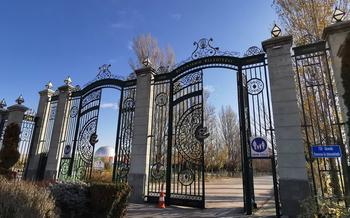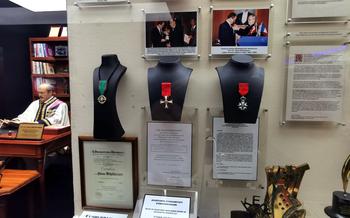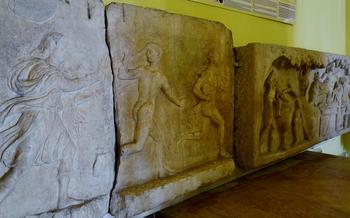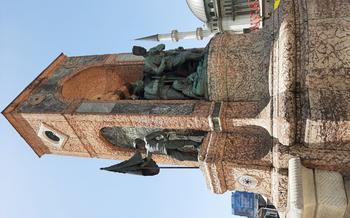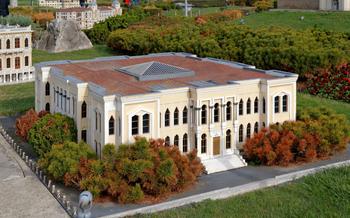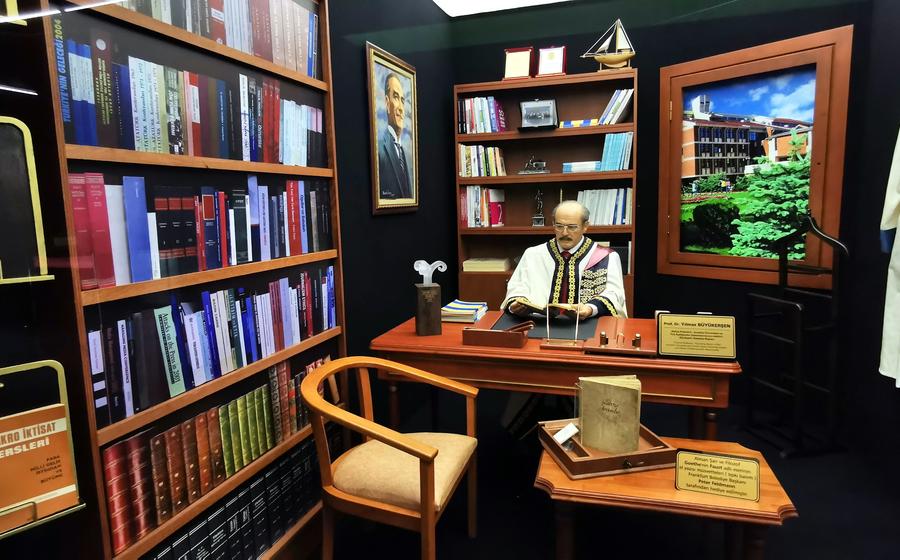
Eskişehir Railway Museum
- Eskişehir's Transformation: From Quiet Town to Vibrant City
- Eskişehir's Railway Heritage
- Exploring the Eskişehir Railway Museum
- Stepping into the Past: An Immersive Experience
- The Star of the Show
- A Journey Through Time: Exploring the Locomotive Collection
- Exploring the Workshops
- The Story of Nazım Hikmet
- More Than Just Locomotives
- A Symbol of Progress
- A Destination for All
- Capturing the Memories
- Preserving the Past for the Future
- Insider Tip:
Eskişehir's Transformation: From Quiet Town to Vibrant City
Eskişehir, once a sleepy town nestled in the heart of Anatolia, underwent a remarkable transformation in the late 19th century, emerging as a vibrant city renowned for its unique identity. This metamorphosis can be attributed to the establishment of the railway line connecting Istanbul to Baghdad and the subsequent construction of the Eskişehir Railway Museum. The railway's arrival brought economic prosperity, attracting people from various regions and cultures, contributing to the city's diverse and dynamic character.
The city's cultural revival was further fueled by the presence of Nazım Hikmet, one of Turkey's most celebrated poets and writers, who spent his childhood in Eskişehir. Hikmet's fascination with trains and his observations of the railway workers found their way into his poetry, reflecting his deep connection to the city's railway heritage. Today, Eskişehir is also recognized as a center for higher education, with several universities attracting a large student population, adding to the city's youthful and cosmopolitan atmosphere.
Eskişehir's Railway Heritage
Eskişehir's deep connection with railways dates back to the Ottoman Empire when the city played a crucial role in the construction of the Anatolian Railway. This ambitious project, initiated in 1888, aimed to connect Istanbul, the capital of the empire, with Baghdad, a major city in the Middle East. The railway's construction transformed Eskişehir into a significant transportation hub, fostering economic growth and development in the region.
The establishment of the Eskişehir Railway Workshops in 1894 further solidified the city's position as a railway center. These workshops were responsible for maintaining and repairing locomotives and rolling stock, ensuring the smooth operation of the Anatolian Railway. The workshops' skilled workforce and advanced facilities made Eskişehir a hub of railway expertise and innovation.
As the railway network expanded, so did Eskişehir's reputation as "The City of Locomotives." The city became synonymous with the iron horse, symbolizing its pivotal role in Turkey's transportation system. The railway's arrival brought not only economic prosperity but also cultural and social transformation, shaping Eskişehir's identity and paving the way for its future development.
Exploring the Eskişehir Railway Museum
Established in 1997, the Eskişehir Railway Museum stands as a testament to Turkey's rich railway history. Its collection boasts a diverse array of locomotives, wagons, and other railway artifacts, spanning different eras of Turkish railway development. The museum's indoor and outdoor exhibits showcase restored locomotives and carriages, providing visitors with an immersive experience into the world of Turkish railways.
Step inside the museum, and you'll be greeted by interactive displays and educational panels that delve into the history and evolution of Turkish railways. These exhibits offer insights into the technical advancements and engineering marvels that have shaped the country's railway system.
The museum's collection includes steam locomotives that once hauled heavy freight trains, sleek diesel locomotives that revolutionized long-distance travel, and electric locomotives that symbolize Turkey's embrace of modern technology. Each locomotive has a unique story to tell, representing different periods and types of railway operations in Turkey.
As you explore the museum, take your time to admire the intricate designs and historical significance of the locomotives and carriages. The museum's collection is a testament to the skill and dedication of the engineers and workers who built and maintained Turkey's railway network.
Stepping into the Past: An Immersive Experience
A visit to the Eskişehir Railway Museum takes you on a journey through time, beginning from the entrance. The layout of the exhibits guides you through the history and evolution of Turkish railways, with interactive displays and educational panels providing insights into the significance of each locomotive and carriage. As you explore the museum, you can view the locomotives and carriages up close, appreciating their intricate designs and historical significance. The museum's collection of photographs, documents, and scale models further enriches the visitor experience, offering a glimpse into the lives of the railway workers and the challenges they faced.
The Star of the Show
Amidst the impressive collection at the Eskişehir Railway Museum, one locomotive stands out as a true star—the "Kurtuluş" locomotive. Built in 1929 and named after the Turkish War of Independence, this locomotive embodies Turkey's journey towards modernization and progress. Its streamlined appearance and advanced technology for its time set it apart as a symbol of innovation and engineering prowess. During the war, the "Kurtuluş" locomotive played a crucial role, hauling important trains and contributing to the nation's victory. Restored to its former glory by the museum, this magnificent locomotive now captivates visitors with its grandeur, serving as a testament to Turkey's rich railway heritage.
A Journey Through Time: Exploring the Locomotive Collection
The Eskişehir Railway Museum boasts an impressive collection of locomotives, providing a comprehensive overview of the evolution of railway technology in Turkey. Visitors can trace the journey from early steam engines, which played a pivotal role in the country's industrialization, to modern diesel and electric locomotives that power today's trains.
The collection includes locomotives used for various purposes, from hauling passenger trains on scenic routes to transporting freight across the country. Each locomotive has a unique story to tell, showcasing the engineering prowess and innovation that have shaped Turkey's railway system over the years.
Highlights of the collection include the "Çukurova" locomotive, built in 1939, which was one of the first diesel locomotives to operate in Turkey, and the "Toros," a powerful electric locomotive introduced in the 1970s to handle the increasing demand for rail transportation.
Preserving these locomotives is of utmost importance, as they serve as tangible reminders of Turkey's railway heritage and the crucial role that railways have played in shaping the country's economy and society. The Eskişehir Railway Museum ensures that these iconic machines are not only preserved but also presented in a way that allows visitors to appreciate their significance and marvel at their engineering achievements.
Exploring the Workshops
The Eskişehir Railway Museum not only showcases locomotives but also delves into the history of railway maintenance and repair through its remarkable workshops. Established in 1894, these workshops played a crucial role in keeping the locomotives of the Anatolian Railway running smoothly. Today, transformed into a museum, the workshops offer a glimpse into the behind-the-scenes operations of a bygone era.
Visitors can explore the workshops' original layout, complete with tools, machinery, and equipment used by skilled workers to maintain and repair locomotives during the steam era. Interactive exhibits provide insights into the daily routines and challenges faced by these workers, showcasing their expertise and dedication. The preservation of the workshops' authenticity allows visitors to experience the atmosphere of a bustling railway hub from over a century ago.
The Story of Nazım Hikmet
One of Turkey's most celebrated poets and writers, Nazım Hikmet, spent his childhood in Eskişehir. His fascination with trains and locomotives is evident in his poetry, reflecting his connection to the city's railway heritage. Hikmet's experiences in Eskişehir and his observations of the railway workers influenced his literary works and social activism. The museum pays tribute to Hikmet, showcasing his manuscripts, photographs, and personal belongings related to his time in Eskişehir. Visitors can gain insights into the life and work of this remarkable figure, whose connection to the railway world left an indelible mark on his creative expression.
More Than Just Locomotives
In addition to its impressive collection of locomotives, the Eskişehir Railway Museum houses a diverse array of other railway artifacts that provide valuable insights into the different aspects of railway operations. These artifacts include carriages, wagons, and railway equipment used for various purposes, such as passenger travel, freight transportation, and signaling systems.
Passenger carriages of different classes and designs showcase the evolution of railway travel in Turkey, from the early wooden carriages to the more modern and comfortable ones. Freight wagons, used to transport goods and materials, demonstrate the crucial role of railways in economic development and trade. Railway equipment, such as signals, lamps, and communication devices, offers a glimpse into the technological advancements that have shaped railway operations over the years.
Preserving these artifacts is essential for safeguarding Turkey's railway heritage and ensuring that future generations can appreciate the intricate details and engineering marvels of these objects. The museum's dedication to restoring and maintaining these artifacts ensures their longevity and educational value.
A Symbol of Progress
The Eskişehir Railway Museum is more than just a repository of locomotives and railway artifacts; it stands as a symbol of Turkey's modernization efforts and industrial development. The museum showcases Turkey's transition from a predominantly agricultural society to an industrialized nation with a modern transportation system. The locomotives and carriages on display represent the technological advancements that transformed Turkey's infrastructure and economy.
The museum highlights the crucial role of railways in economic growth and social progress. The Anatolian Railway, which connected Istanbul to Baghdad, was a lifeline for trade and commerce, facilitating the transportation of goods and people across the region. The establishment of the Eskişehir Railway Workshops further cemented the city's position as a hub of railway innovation and engineering.
The Eskişehir Railway Museum serves as a reminder of Turkey's rich industrial heritage and the important role that railways played in shaping the nation's progress. It is a testament to the vision and determination of those who worked tirelessly to build a modern and efficient transportation system that would connect Turkey to the rest of the world.
Through its exhibits and educational programs, the museum aims to inspire young people to pursue careers in engineering and transportation, fostering a new generation of innovators who will continue to drive Turkey's progress forward.
A Destination for All
The Eskişehir Railway Museum is a popular tourist destination, attracting visitors from across Turkey and beyond. The museum's unique collection and interactive exhibits make it an educational and enjoyable experience for people of all ages. Children are fascinated by the massive locomotives and carriages, while adults can appreciate the historical significance of the exhibits. The museum is also accessible for visitors with disabilities, with ramps and elevators providing easy access to all areas. Guided tours are available in multiple languages, ensuring that international visitors can also learn about the history of Turkish railways. The museum is integrated into Eskişehir's broader cultural offerings, with its proximity to other museums, parks, and historical sites, making it an ideal destination for a day of exploration and learning.
Capturing the Memories
The Eskişehir Railway Museum is a treasure trove for photography enthusiasts, with its collection of locomotives, carriages, and historical artifacts providing a unique and picturesque backdrop for capturing memorable photographs. The museum's carefully curated exhibits, combined with its atmospheric setting, create an ideal environment for photographers of all skill levels to unleash their creativity. Whether you're a professional photographer looking for your next masterpiece or a casual shutterbug seeking unique shots, the Eskişehir Railway Museum offers endless opportunities to capture the essence of Turkey's railway heritage.
Remember to respect the museum's guidelines and regulations regarding photography, ensuring that you don't disrupt other visitors or damage the exhibits. By following these guidelines, you can help preserve the museum's collection for future generations while capturing your own unforgettable memories. Share your photographs on social media and online platforms, using the appropriate hashtags, to promote the museum and its collection to a wider audience, inspiring others to discover the wonders of Turkey's railway heritage.
Preserving the Past for the Future
The Eskişehir Railway Museum stands as a testament to the enduring significance of Turkey's railway heritage. By preserving historical locomotives, carriages, and railway artifacts, the museum plays a vital role in documenting and conserving the nation's rich transportation history. Through its exhibits and educational programs, the museum educates future generations about the importance of railways in Turkey's development and modernization.
Furthermore, the museum actively collaborates with other institutions and organizations to promote railway heritage and raise awareness of its importance. By sharing knowledge and resources, the museum contributes to a broader understanding and appreciation of Turkey's railway past. In doing so, the Eskişehir Railway Museum ensures that the legacy of the iron horse remains alive and well for generations to come.
Insider Tip:
For the best experience, plan your visit to the Eskişehir Railway Museum during the shoulder season (spring or autumn) to avoid the summer crowds. Check the museum's website or social media pages for information on special events, exhibitions, or educational programs that may align with your interests. Guided tours in multiple languages are available, and advance booking is recommended to secure your spot. To make the most of your trip, combine your visit to the museum with other attractions in Eskişehir, such as a leisurely stroll along the scenic Porsuk River, exploring the historic Odunpazarı District, or immersing yourself in the vibrant atmosphere of the Anatolian University campus.

